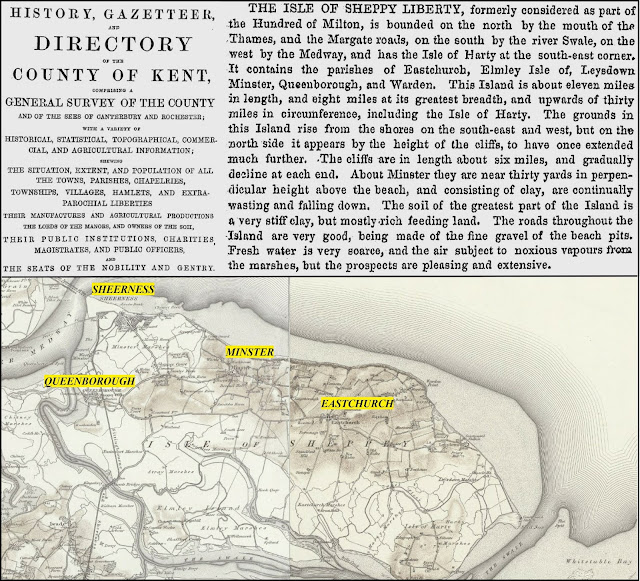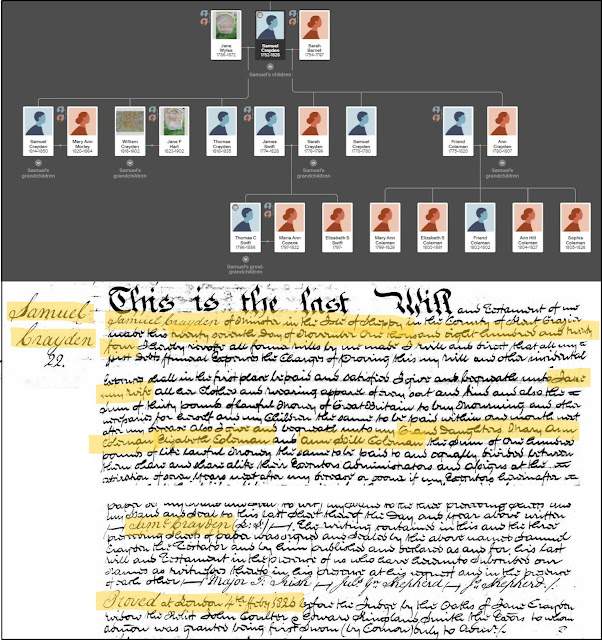The will also appears to makes arrangements for her apprentice, George Markett, and servant, Mary Cooper, to be suitably attired for her funeral - bequeathing ten pounds and a Suit of Mourning to George and a new Black
Bombazine Gown to Mary.
But there's also another useful detail about Elizabeth's trade contained within the will. It states that "I give and bequeath my Shop for the residue of the term of years now to come of the Lease and all my Trade and Business of a Butcher to the said Samuel Crayden and do direct that he carry on and exercise the same therein":
A further part of the 1798 Land Tax records for the Isle of Sheppey, this time for Minster, also lists James Swift (either father or son) as a tenant and, in this part of the record, Samuel Crayden as an owner of land:
In short, these two wills, alongside other historical records, show that these two Sheppey families, who have made at least some initial wealth from the meat trade, have been linked together through the 1794 marriage of James Swift and Sarah Crayden. That joining together of families is also confirmed in the name of their first child, Thomas Crayden Swift.
Into the nineteenth century with their grandchildren
a) Elizabeth Swift
The will above bequeaths the income from the sale of (the senior) Elizabeth Swift's property to two grandchildren, Elizabeth and Thomas Crayden Swift. Little can be found in the historical records, at least reliably, about the grand daughter. There is a record of the baptism of an Elizabeth Sarah Swift in Minster on 4th November 1797, and then of a death, in the same parish, of an Elizabeth Swift on 27th May 1841, just before the date of the first modern UK census, which took place on the 6th June 1841. If this is the grand daughter, then this will explain why there is no clear trace of her in any of the census records. However, there is plenty on record about the long life of Thomas Crayden Swift, my third great-grandfather.
b) Thomas Crayden Swift
The age listed on all of the later census records, from 1841 to 1881, suggests that Thomas Crayden Swift was born in Minster, Sheppey, Kent, in 1796. For example, the 1881 census gives his age as 85:
According to the 1886 burial register for his grave in the Old Brompton Cemetery, Kensington & Chelsea, he lived until the age of 91:
Within that long lifetime, there are also marriage records for three different wives and, from these three successive marriages, fifteen (!) surviving children:
Thomas Crayden Swift - up until the 1841 census
The first half of Thomas Crayden Swift's life took place before the first modern UK census of 1841. However, it's still possible to piece together an account of his early life from the other records that still exist, taken from various different villages across Kent:
a) First marriage and first four children
The earliest clear historical records in the life of Thomas Crayden Swift are from his marriage to his first wife, Susannah Foord. This took place on (or around, as the sources vary slightly on the exact date) 13 December 1815. It seems that Thomas was not yet 20, but his wife 26.
There is one slight puzzle, in that while the parish records clearly state the marriage place as being Minster-in-Sheppey (see above), the banns of marriage are recorded as having been published in London's
St.George the Martyr Church, Southwark, with Thomas and Susannah being "both of this parish":
The names are so distinctive that it seems unlikely that this can be anything but the same bride and bridegroom. However, wherever exactly the couple were residing before the wedding, later census records confirm that their four children were all born on the Isle of Sheppey: John Crayden in 1816, Thomas in 1818 and William in 1820 - all born in Minster - and then Mary Ann in 1822 in Eastchurch:
However, if the
fading inscription on a gravestone in the churchyard of
St. Mary the Virgin in the Kent village of Stowting has been correctly read, then Susannah dies in the year that her last child was born, 1822, also in Eastchurch, Sheppey, perhaps even in childbirth. She was buried alongside her mother, and later her father, in Stowting:
b) Second marriage and three more children
After Susannah's death in 1822, Thomas Crayden, now aged 29, remarried in 1825 in the village of Chilham, near Canterbury in Kent. His second wife, then aged 28, was my 3rd great grandmother, Maria Ann Cozens.
The parish and later census records show that Maria Ann gave birth to three children, all at Eastchurch: James Cozens Swift in 1826, Edward Crayden Swift in 1829 and Samuel Crayden Swift in 1830.
Maria Ann had been baptised in Chilham in 1796, the daughter of James and Anne Cozens, who had also been married in the same village on 14th February 1787. However, Maria Ann died at the age of only 35, and was buried on the 8th August 1831 in
All Saints Churchyard, Eastchurch.
 |
| All Saints Churchyard, Eastchurch, Sheppey. |
c) Third marriage and eight more children
Once again, after the death of Maria Ann, Thomas Crayden remarries, this time in Eastchurch, on 14 May 1832. His new bride, Ann Graves, was born on 28th February 1810 in Hoo St Werburgh, a village across the Medway from the Isle of Sheppey. As the 1841 census confirms, this third wife, now Ann Swift, is 15 years younger than her husband Thomas. So, when married, Thomas was 36, Ann just 21:
The 1841 census also shows that, as well as Thomas and Ann, children from all three marriages are living in the same Eastchurch household: William (20); Edward (13) and Samuel (11); and Ann's first four children - Richard (8), Elizabeth (6), George (4) and Ann (2). As will be seen in a further post, Ann will give birth to four further daughters at Eastchurch during the 1840s.
A butcher, a voter, a tenant at various farms ... and nearly bankrupt
How was Thomas Crayden Swift generating the income required to support this large family? The 1841 census suggests the answer - by continuing the family trade of previous generations - as a butcher. This is also backed up by a copy of the 1840's Pigot's Directory for Kent where Thomas Craydon Swift is listed as one of the butchers of Sheerness - but the only one listed for Eastchurch:
Thomas Crayden Swift also had enough standing to qualify as a registered voter after the extension of the franchise under the
1832 Reform Act. This may well have been through being a leaseholder, rather than anyone of greater wealth, but nevertheless was sufficient for him to be able to vote in the 1832 General Election.
His trade - and his position as a tenant - is illustrated really well by a later 1842 document put together by the
Kent Archaeology Society showing him occupying land in Eastchurch owned by various landlords, including a slaughter house and yard, "the poor meadow" pasture, a house and garden and a butcher's shop!
Showing that names have not changed much over the years, New Hook Farm and Garretts Farm can still be found on a web search of Sheppey - although the latter appears in 2012 local news as being raided as an
illicit cannabis factory!
 |
| New Hook Farm on Google Maps - ME12 3SU |
As a tenant, and in the absence of a secret vote, it is perhaps not surprising that, whether a confirmed Tory or not, Thomas Crayden Swift's vote in the 1832 General Election for Eastern Kent is recorded as being in favour of candidate "K" - the powerful sitting MP, "Ultra-Tory" Sir Edward Knatchbull. In addition, although recorded as residing in Eastchurch, his qualifying property is listed as being in another Kent village, Boughton under Blean:
 |
| From the Poll Book for Eastern Kent, 1832 |
Knatchbull was elected, although the Whigs won nationally by a large majority, in an election taking place against the background of electoral reform and only two years after the '
Swing Riots', provoked by the abject poverty facing agricultural labourers - which had begun right here in Eastern Kent. Disease was also an issue on Sheppey itself, with
cholera apparently spreading from the prison hulks moored at
Stangate Creek, close to Queenborough, at the mouth of the Medway.
But, as a final detail in this post, Thomas Crayden Swift does not appear as a tenant or property owner in the
1842 tithe record for Boughton under Blean (although 'Dowager Lady Knatchbull' does!). There's a chance that perhaps Thomas had been overstretching himself because he is named in the published list of bankrupts for January 1833, as a 'victualler and butcher' of Eastchurch, Kent.
Thomas Crayden Swift was ordered to appear at the Court of Bankruptcy in the City of London at "half past Ten in the Forenoon precisely" on 5th February 1833 to "make a full discovery and disclosure of his estate and effects, when and where the Creditors are to come prepared to prove their debts". A second hearing was set for March 8th, to "finish his examination". It appears he was able to settle his debts, as he is later listed under "bankruptcies superseded" but also had to pay considerable court fees to extricate himself from the situation.
In my next post ...
Perhaps his experience in the Bankruptcy Court was a salutary one for, as the next post will show, it seems that both Thomas Crayden Swift, and many of his children, were able to continue to earn their living through the butcher's trade. However, they took their skills to London, to make their living from feeding the growing population of the capital city.




























Comments
Post a Comment